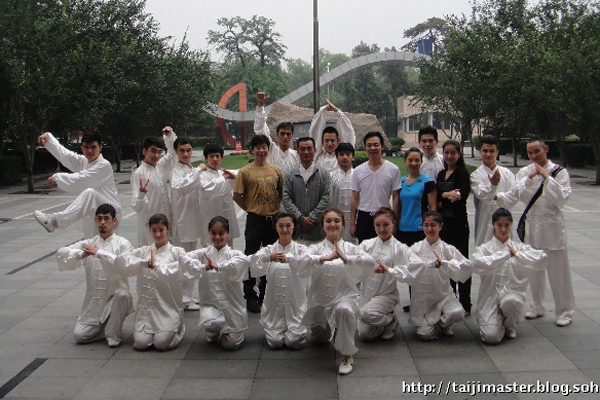|
Tai Chi returns to prominence as followers seek inner peace
Among the chirps of the birds, the sun rose behind the horizon, awakening Beijing, the ancient capital of China, with its fierce, penetrating light. Donning traditional Chinese cheongsam and loose trousers, people flocked to Zi Zhu Yuan (literally, “Purple Bamboo Park”) in western Beijing, pulling the crumpled corner of the Kung-fu costumes and getting ready for the start of their morning exercises.
As a melody with a moderate rhythm began to play, these exercisers, lining up side by side, slowly raised one of their legs, while gently pushing out their hands. They were practicing Tai Chi, one of the oldest and mildest forms of kung fu in China, whose ultimate goal is to search for the invisible harmony between human bodies and the nature. "In combining traditional Chinese aesthetics, medicines and philosophies, Tai Chi is virtually the practice of one’s attitude towards life," Jing Jianjun, one of the 12th successors of Chen-Style Tai Chi, told China.org.cn recently after his morning exercises in Zi Zhu Yuan. "We all feature Tai Chi in our own bodies, [in harmony] with many good elements in life," he said. Tai Chi, originated from Chen Style in Chenjiagou, Henan Province and gradually developed into styles of Chen (陈), Yang (杨), Wu (武), Wu (吴) and Sun (孙), expanding from Henan to Hebei and Shanxi provinces, incorporates the dialectic philosophies of Taoism and I Ching (YI Jing 《易经》), as well as specialized breathing methods and Chinese medical theories. It has been listed as an integral part of China’s intangible cultural heritage since 2006. Tai Chi encourages people to keep their bodies in equilibrium by expelling compulsive force with natural and gentle movements. Practitioners are expected to tackle external forces without violence, instead relying on the blow of the attack to resolve the force. According to Jing, students eventually forget themselves and achieve inner peace when they become totally involved in the practice of Tai Chi. This so-called inner peace usually comprises the Yin (阴, "female") and Yang (阳, "male") as well as the Xu (虚, "emptiness") and Shi (实, "fullness"). However, practicing Tai Chi is not an inherited ability ― results, instead, depend much on one's experience, cultivation and wisdom, Jing said. Kung fu is comprised of three stages, he explained: to learn, to practice and to understand. "It would be better to learn from a good teacher and practice harder and harder; then you can finally understand its fundamental rules," Jing said. Today, as part of recent trend to reconnect with China’s treasured culture heritage, large numbers of Chinese people are embracing the practice of Tai Chi. "People used to think Tai Chi, as with many of our traditional cultures, as out-of-date, but now I believe that kung fu has become fashionable," said Lei Haiping, a participant in Jing's Tai Chi training class. "[Tai Chi] is the simplest practice in line with the rules of nature, and persistency is the only way to master it," Lei said.
|
| Copyright © China.org.cn. All Rights Reserved 京ICP证 040089号 京公网安备110108006329号 网络传播视听节目许可证号:0105123 京公网安备110108006329号 京网文[2011]0252-085号 |

 0
0 








Go to Forum >>0 Comment(s)